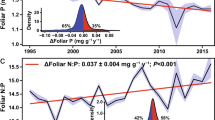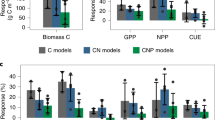Abstract
Forests strongly affect climate through the exchange of large amounts of atmospheric CO2 (ref. 1). The main drivers of spatial variability in net ecosystem production (NEP) on a global scale are, however, poorly known. As increasing nutrient availability increases the production of biomass per unit of photosynthesis2 and reduces heterotrophic3 respiration in forests, we expected nutrients to determine carbon sequestration in forests. Our synthesis study of 92 forests in different climate zones revealed that nutrient availability indeed plays a crucial role in determining NEP and ecosystem carbon-use efficiency (CUEe; that is, the ratio of NEP to gross primary production (GPP)). Forests with high GPP exhibited high NEP only in nutrient-rich forests (CUEe = 33 ± 4%; mean ± s.e.m.). In nutrient-poor forests, a much larger proportion of GPP was released through ecosystem respiration, resulting in lower CUEe (6 ± 4%). Our finding that nutrient availability exerts a stronger control on NEP than on carbon input (GPP) conflicts with assumptions of nearly all global coupled carbon cycle–climate models, which assume that carbon inputs through photosynthesis drive biomass production and carbon sequestration. An improved global understanding of nutrient availability would therefore greatly improve carbon cycle modelling and should become a critical focus for future research.
This is a preview of subscription content, access via your institution
Access options
Subscribe to this journal
Receive 12 print issues and online access
$209.00 per year
only $17.42 per issue
Buy this article
- Purchase on Springer Link
- Instant access to full article PDF
Prices may be subject to local taxes which are calculated during checkout



Similar content being viewed by others
Change history
28 May 2014
In the version of this Letter originally published, the following text was omitted from the acknowledgements section: 'We also thank all site investigators, their funding agencies, the various regional flux networks (Afriflux, AmeriFlux, AsiaFlux, CarboAfrica, CarboEurope-IP, ChinaFlux, Fluxnet-Canada, KoFlux, LBA, NECC, OzFlux, TCOS-Siberia, USCCC), the Office of Science (BER) and US Department of Energy (for funding the development of measurement and data submission protocols), and the Fluxnet project, whose work and support is essential for obtaining the measurements without which the type of integrated analyses conducted in this study would not be possible.' This has been corrected in the online versions of the Letter.
13 March 2015
In the version of this Letter originally published, in the final paragraph, the section of text including 'Earth system models should … nutrient cycling)' was misleading and should have been: "Models simulating the dynamics of the terrestrial biosphere currently consider the effects of nitrogen on vegetation and soils25,26 but they still do not consider the effects of other nutrients such as phosphorus or potassium. Future models should consider the interactions of nitrogen as well as these other nutrients with the entire forest carbon balance. The relationship between GPP and NEP appears to be so strongly controlled by the nutrient status of the forest that terrestrial biosphere models may be unable to accurately predict the carbon balance of forest ecosystems without information on background nutrient availability27—soil nitrogen, phosphorous, potassium, pH—and on changes in soil and plant nutrient cycling resulting from human activities (such as nitrogen deposition, climate change and elevated CO2)." To accommodate these changes, the original ref. 27 (W. De Vries and M. Posch, M. Environ. Pollut. 159, 2289-2299; 2011) was removed and the remaining references renumbered. The original references numbered 31–33 have been moved to the Supplementary Information, as they are uncited in the main text.
References
Dixon, R. K. et al. Carbon pools and flux of global forest ecosystems. Science 263, 185–90 (1994).
Vicca, S. et al. Fertile forests produce biomass more efficiently. Ecol. Lett. 15, 520–526 (2012).
Janssens, I. A. et al. Reduction of forest soil respiration in response to nitrogen deposition. Nature Geosci. 3, 315–322 (2010).
Valentini, R. et al. Respiration as the main determinant of carbon balance in European forests. Nature 404, 861–865 (2000).
Kato, T. & Tang, Y. Spatial variability and major controlling factors of CO2 sink strength in Asian terrestrial ecosystems: Evidence from eddy covariance data. Glob. Chang. Biol. 14, 2333–2348 (2008).
Piao, S. et al. Footprint of temperature changes in the temperate and boreal forest carbon balance. Geophys. Res. Lett. 36, L07404 (2009).
De Vries, W. et al. The impact of nitrogen deposition on carbon sequestration by European forests and heathlands. For. Ecol. Manage. 258, 1814–1823 (2009).
Fernández-Martínez, M. et al. Spatial variability and controls over biomass stocks, carbon fluxes and resource-use efficiencies in forest ecosystems. Trees Struct. Funct. 28, 597–611 (2014).
Luyssaert, S. et al. CO2 balance of boreal, temperate, and tropical forests derived from a global database. Glob. Chang. Biol. 13, 2509–2537 (2007).
Hijmans, R. J., Cameron, S. E., Parra, J. L., Jones, P. G. & Jarvis, A. Very high resolution interpolated climate surfaces for global land areas. Int. J. Climatol. 25, 1965–1978 (2005).
Reichstein, M. et al. On the separation of net ecosystem exchange into assimilation and ecosystem respiration: Review and improved algorithm. Glob. Chang. Biol. 11, 1424–1439 (2005).
Vickers, D., Thomas, C. K., Martin, J. G. & Law, B. Self-correlation between assimilation and respiration resulting from flux partitioning of eddy-covariance CO2 fluxes. Agric. For. Meteorol. 149, 1552–1555 (2009).
Lasslop, G., Reichstein, M., Detto, M., Richardson, A. D. & Baldocchi, D. D. Comment on Vickers et al: Self-correlation between assimilation and respiration resulting from flux partitioning of eddy-covariance CO2 fluxes. Agric. For. Meteorol. 150, 312–314 (2010).
Litton, C. M., Raich, J. W. & Ryan, M. G. Carbon allocation in forest ecosystems. Glob. Chang. Biol. 13, 2089–2109 (2007).
Manzoni, S., Taylor, P., Richter, A., Porporato, A. & Agren, G. I. Environmental and stoichiometric controls on microbial carbon-use efficiency in soils. New Phytol. 196, 79–91 (2012).
Shan, J., Morris, L. A. & Hendrick, R. L. The effects of management on soil and plant carbon sequestration in slash pine plantations. J. Appl. Ecol. 38, 932–941 (2002).
Goulden, M. L. et al. Patterns of NPP, GPP, respiration, and NEP during boreal forest succession. Glob. Chang. Biol. 17, 855–871 (2011).
Chapin, F. S. The mineral nutrition of wild plants. Annu. Rev. Ecol. Syst. 11, 233–260 (1980).
Burton, A., Pregitzer, K., Ruess, R., Hendrick, R. & Allen, M. Root respiration in North American forests: Effects of nitrogen concentration and temperature across biomes. Oecologia 131, 559–568 (2002).
Lee, S. C. et al. A protein phosphorylation/dephosphorylation network regulates a plant potassium channel. Proc. Natl Acad. Sci. USA 104, 15959–15964 (2007).
Keith, H., Mackey, B. G. & Lindenmayer, D. B. Re-evaluation of forest biomass carbon stocks and lessons from the world’s most carbon-dense forests. Proc. Natl Acad. Sci. USA 106, 11635–11640 (2009).
Cotrufo, M. F., Wallenstein, M. D., Boot, C. M., Denef, K. & Paul, E. The Microbial Efficiency-Matrix Stabilization (MEMS) framework integrates plant litter decomposition with soil organic matter stabilization: Do labile plant inputs form stable soil organic matter? Glob. Chang. Biol. 19, 988–995 (2013).
Peñuelas, J., Sardans, J., Rivas-ubach, A. & Janssens, I. A. The human-induced imbalance between C, N and P in earth’s life system. Glob. Chang. Biol. 18, 3–6 (2012).
Peñuelas, J. et al. Human-induced nitrogen–phosphorus imbalances alter natural and managed ecosystems across the globe. Nature Commun. 4, 2934 (2013).
Zaehle, S. & Friend, A. D. Carbon and nitrogen cycle dynamics in the O-CN land surface model: 1 model description, site-scale evaluation, and sensitivity to parameter estimates. Glob. Biogeochem. Cycles 24, GB1005 (2010).
Zaehle, S., Friedlingstein, P. & Friend, A. D. Terrestrial nitrogen feedbacks may accelerate future climate change. Geophys. Res. Lett. 37, L01401 (2010).
Piao, S. et al. Evaluation of terrestrial carbon cycle models for their response to climate variability and to CO2 trends. Glob. Chang. Biol. 19, 2117–2132 (2013).
R Core Team R: A language and environment for statistical computing. R Found. Stat. Comput. 1, 409 (2013).
Grömping, U. Relative importance for linear regression in R: The package relaimpo. J. Stat. Softw. 17, 1–27 (2006).
Acknowledgements
This research was supported by the Spanish Government projects CGL2010-17172 and Consolider Ingenio Montes (CSD2008-00040), by the Catalan Government Grants SGR 2009-458 and FI-2013 and by the European Research Council Synergy grant 610028, P-IMBALANCE. S.V. and M.C. are postdoctoral fellows of the Research Foundation - Flanders (FWO). S.L. was financially supported by ERC Starting Grant 242564 and received additional financial support from FWO Vlaanderen. We appreciate the financial support of the GHG-Europe project. We also thank all site investigators, their funding agencies, the various regional flux networks (Afriflux, AmeriFlux, AsiaFlux, CarboAfrica, CarboEurope-IP, ChinaFlux, Fluxnet-Canada, KoFlux, LBA, NECC, OzFlux, TCOS-Siberia, USCCC), the Office of Science (BER) and US Department of Energy (for funding the development of measurement and data submission protocols), and the Fluxnet project, whose work and support is essential for obtaining the measurements without which the type of integrated analyses conducted in this study would not be possible.
Author information
Authors and Affiliations
Contributions
M.F-M., S.V., I.A.J. and J.P. conceived the paper and analysed the data. All authors contributed substantially to the discussion and the text writing.
Corresponding author
Ethics declarations
Competing interests
The authors declare no competing financial interests.
Supplementary information
Rights and permissions
About this article
Cite this article
Fernández-Martínez, M., Vicca, S., Janssens, I. et al. Nutrient availability as the key regulator of global forest carbon balance. Nature Clim Change 4, 471–476 (2014). https://doi.org/10.1038/nclimate2177
Received:
Accepted:
Published:
Issue Date:
DOI: https://doi.org/10.1038/nclimate2177
This article is cited by
-
Carbon Stocks and Transfers in Coniferous Boreal Forests Along a Latitudinal Gradient
Ecosystems (2024)
-
Forest microbiome and global change
Nature Reviews Microbiology (2023)
-
How climate policy commitments influence energy systems and the economies of US states
Nature Communications (2023)
-
Diagnosing destabilization risk in global land carbon sinks
Nature (2023)
-
No impact of nitrogen fertilization on carbon sequestration in a temperate Pinus densiflora forest
Scientific Reports (2023)



